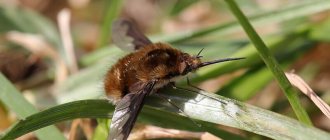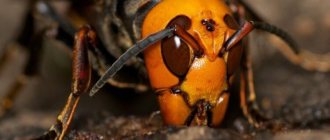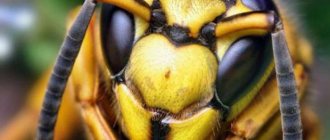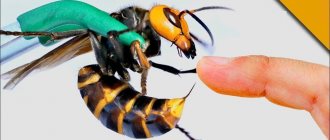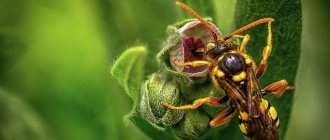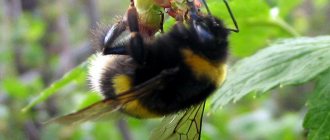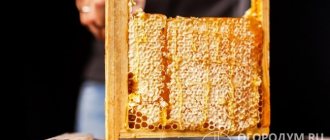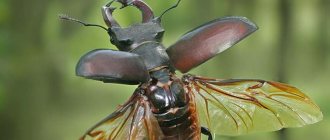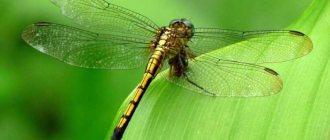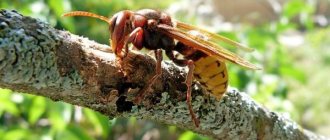A menacing buzzing makes many people anxious, and if something similar to a hornets’ nest appears in sight, there is a desire to get as far away from the dangerous place as possible. This is how people react to a potential threat. And this is correct, because the maximum risk of a bite occurs within a radius of 2–3 m from the nest.
Who is a hornet and why is it dangerous to humans? What to do if it bites and what could be the consequences? How to get rid of them and how do they differ from bees, wasps and bumblebees? Let's figure it out.
Who is the hornet
This is the largest representative of the so-called paper or social wasps. Their Latin name is Vespa, which literally translates as “wasp”. However, these are different insects that belong to the same family - true wasps.
Initially, no difference was made between the two representatives, and only in the 19th century the Vespa genus was divided into two groups. The description was based on several characteristics, but the main one was size - hornets are larger and can reach a length of up to 5.5 cm. Insects that are today considered wasps are designated in Latin as Vespula, that is, “small wasp.” Their size is 1.5–2 cm in length.
In the names of the hornet, given to it by residents of different countries, the roots of the words “horns” and “head” can be traced, which indicates the peculiarity of its structure - the increased size of the head and the presence of movable antennas. The fear of the hornet is reflected in the names - “evil man” (Old Russian, Polish), “pirate”, “winged corsair”.
The hornet's threatening appearance is given by the bright coloring of its head - a combination of yellow, black, and orange. The aggressive image is complemented by a striped belly, strong jaws and large eyes. However, these insects, unlike wasps, are non-aggressive. Human bites occur when a nest is disturbed or in self-defense.
Listen to the sound of the hornet:
Biological description
Hornets belong to the genus - social wasps. They live in families. A swarm can include up to several thousand individuals. Their life processes are clearly organized. Thus, within the “community” there are separate “castes” that perform specific functions.
The task of the hornet queen is to leave offspring. She is the leader of the colony. Females are born from fertilized eggs in August and September. Hornets reproduce by mating mature insects. After the females are fertilized, the males die.
The female stores sperm during the winter. With the onset of warm spring days, the queen begins to actively feed and regain strength in order to begin creating honeycombs for laying eggs. Thus, it forms the foundation of the future nest.
How long a hornet lives depends on its “profession”. Thus, males exist for one season, and the lifespan of the queen is a year.
In workers and the uterus, at the end of the abdomen there is a reproductive organ - the ovipositor, which is also a sting. In normal condition it is located inside. At the base of the ovipositor there is a paired gland containing a reservoir of poison that has a complex chemical composition. The hornet's sting is straight and smooth. The venom contains toxins that can affect the victim's nervous system.
The insect also has powerful jaws - mandibles. Literally speaking, hornets not only sting by injecting poison, but also bite. The insect uses mandibles to tear and grind prey.
During the active season, hornets feed on the juice of overripe fruits, trees, and honey. They hunt caterpillars, dragonflies, flies, spiders, related bees and wasps. They also cope with larger insects - crickets, locusts. There are descriptions of species capable of attacking birds and frogs. The prey is not used for food—the mass chewed and treated with saliva is used to feed the larvae.
Nests
The structure of a hornet's nest is based on hexagonal honeycombs.
The material is a substance similar to paper or cardboard. This is a lightweight structural element with thermal insulation properties of a brown color, which is obtained by mixing tree bark with insect saliva.
The place for the nest is chosen by the queen hornet. She does it where the offspring will be protected from excessive heat, cold and prying eyes.
Hornet nests reach 50–70 cm in length and are located in tree hollows, abandoned or used premises, cavities under roots, and piles of dead wood.
In the European Union, hornets are protected by law. For example, in Germany, the destruction of their nests is punishable by a large fine.
Area
Most species of hornets live in areas with a temperate climate, mainly in the northern hemisphere. Entomologists believe that they originally lived primarily in East Asia. There are several types of hornets on the territory of Eurasia, mainly the common and oriental ones.
People themselves play a major role in the spread of the insect. For example, a representative of the “common” species came to North America along with colonists from Europe in the middle of the 19th century.
In Russia, the hornet lives on a vast territory, which includes the European part of the Urals, Transbaikalia, the Amur region, and southern Sakhalin.
Kinds
Representatives of the extensive Vespa genus include more than 20 species.
- Affinis - small striped one.
- Analis - found in East Asia, measuring 25–28 mm.
- Basalis - basal.
- Bellicosa - warlike.
- Bicolor - two-color.
- Binghami - Binghama - active at night.
- Crabro - ordinary.
- Ducalis - commander's - one of the largest in Russia.
- Velutina is tropical, but also lives in Europe, as it was accidentally introduced there.
- Dybowskii - Dybovsky - almost monochromatic - black-brown.
- Fervida - ardent.
- Fumida - variable.
- Mandarinia is the largest in the world and also very poisonous.
- Mocsaryana - lives in Asia.
- Multimaculata - multi-spotted.
- Orientalis - eastern.
- Philippinensis - Philippine.
- Luctuosa is tropical, found in the Philippines and is the most poisonous.
- Simillima - similar, very similar to the common hornet.
- Vivax - lives in Asia.
- Soror - black-tailed.
- Tropica - tropical.
Eight species of hornets live in Russia. The leader in occurrence is the “ordinary” (Vespa Crabro), which is distributed throughout almost the entire country, including the Moscow region. It is absent only in northern latitudes. The eastern hornet (Vespa Orientalis) lives in the Caucasus. In the south of the Far East, six species of Vespa are found - Simillima, Dybowskii, Ducalis, Mandarinia, Analis, Dinghami.
Common hornet (Vespa Crabro)
Role in nature
Hornets occupy their niche in the environment. Like all participants in biological processes, they play a positive role in nature. But sometimes they can also cause harm. For example, they gnaw on trees, trying to get to the sap.
The benefits that hornets bring:
- destroy harmful insects that parasitize garden crops and wild plants - aphids, mites, psyllids;
- pollinate plants;
- They hunt locusts, flies, wasps, sick, “old” bees.
Natural enemies of hornets in nature limit their population within useful limits and destroy sick individuals. Among animals, these are ants, some species of birds (starlings, wagtails). Hornets are also susceptible to parasites - mites, nematodes, parasites and even microscopic fungi.
Interesting Facts
There are more than 20 species of hornets in the world, differing in color, behavioral characteristics, and size. The largest representative is the Asian one (Vespa Mandarinia), whose length exceeds 5 cm. In China, it is known as the “bee tiger”. Its venom contains a neurotoxin.
The hornet's queen releases pheromones that influence males. With their help, the “queen” organizes the activities of the entire swarm.
In the 18th century, the French naturalist, physicist and mathematician René Antoine Reaumur studied the material from which wasps build their nests. The result was a proposal to use wood in the production of paper, because until that moment, it was made from rags.
Life cycle
An entire generation of giant wasp comes from one queen.
Spring
In the spring, she is looking for a place to start building for the new generation. The Queen produces the first honeycomb herself. Later the queen lays eggs in them. After a few days, larvae appear, which need animal food. The female catches caterpillars, beetles, butterflies, and other insects to feed her offspring. The grown larva secretes and becomes a pupa. After 14 days, the young individual gnaws the cocoon.
Summer
In mid-summer, working females and males grow up. They complete the honeycombs and bring squirrels to the larvae. The queen no longer leaves the home and lays eggs.
Life expectancy is short. Insects grow by the end of summer, but in September a significant part die. Surviving individuals can survive until the first cold weather.
Autumn
The population peaks in September. The queen lays eggs during her last clutch. From them females emerge, which subsequently become new queens.
Previous individuals are obtained with modified ovaries. Their functions are suppressed by the queen's pheromones. The young swarm near the hive and mate. Sperm collected in the fall is stored to create a new generation. After mating ends, the male can live up to 7 days. The old queen is kicked out.
Why is a hornet dangerous for humans?
Insect venom contains a number of toxic substances that can act not only at the site of the bite, but also affect the entire body.
The following components of the poison pose a danger to humans:
- phospholipase A2 is an enzyme that activates the inflammatory response;
- acetylcholine is a neurotransmitter that ensures the transmission of impulses;
- histamine is a mediator of immediate allergic reactions;
- mastoparan is a toxin of protein origin.
As a result of the influence of a “bouquet” of biologically active substances on the tissues of the human body, a protective systemic inflammatory response develops.
A hornet sting can be fatal to humans if the victim experiences an allergic reaction. The following complications may also develop:
- skin rashes;
- bronchospasm - obstruction of the airways with difficulty exhaling;
- hallucinations;
- paroxysmal pain in various parts of the abdomen, nausea, vomiting;
- convulsive syndrome;
- depression of consciousness;
- a sharp decrease in blood pressure with further cessation of blood circulation.
Single hornet bites during pregnancy and lactation do not pose a danger to the fetus and infant, since the amount of poison is insignificant to penetrate the placental barrier or into the liver of a nursing mother.
How dangerous is a hornet bite for a child? Due to the small body weight, the concentration of poison for his body is very high, so the symptoms are more pronounced. And also due to the fact that children react actively and unpredictably to buzzing insects, the risk of multiple attacks increases, increasing the development of allergic reactions. In order not to risk the child’s life if bitten, you should immediately call an ambulance, without waiting for allergies to appear and anaphylactic shock to develop.
Lifestyle
Insects create a colony. They are active at any time. Sleep time takes a few minutes. In case of danger, they begin to defend their swarm and queen. When feeling anxious, the queen releases an alarm pheromone - a special substance that activates other relatives to attack.
Its natural habitat is forest. Due to the active cutting down of trees, insects are looking for new places to live. For this reason, they can be found in the garden and in outbuildings. The fight against them is carried out when the population is small. Only specialists can handle a large colony.
Insects are inherently hierarchical. The head of the colony is the queen. She is the only female capable of laying fertilized eggs. Working females and males serve the queen and larvae. There can only be one uterus; when it is exhausted, a new one is found.
It is not recommended to make sudden movements or shake the nest. Also, you should not kill hornets near the hive, since a dying individual transmits an alarm signal and encourages an attack.
Causes of a hornet sting
The main reason for a hornet bite is self-defense, and it always tries to get away from a person first and stings only if it is grabbed.
The insect uses its sting only for the purpose of protection or to neutralize a resisting victim. Entomologists explain that hornets will not consume poison without justified biological expediency. After all, this is a valuable weapon that is necessary during hunting.
Having detected a threat, hornets release alarm pheromones, which call on other individuals to attack. Therefore, everyone who is within a radius of 2–3 meters from a disturbed nest or a killed hornet will be bitten.
Creating a Nest
Hornet's nest.
To create a nest, hornets choose a secluded place that is protected from drafts. Insects are excellent architects. They are able to create unique homes.
Birch or ash wood is used in construction. It is moistened with saliva. The surface of the nest is similar to cardboard or corrugated paper. The structure expands downward. There are about 500 cells in a honeycomb. The color of the cocoon is influenced by the wood. Most often it has a brown color.
Bite symptoms
The hornet does not leave a sting when it bites, so it can sting several times. This feature distinguishes it from bees. A large number of bites can be fatal to humans. Especially if you are allergic to wasp venom.
Symptoms that develop from a hornet bite:
- sharp, severe pain;
- swelling, redness;
- itching, burning at the bite site;
- increase in body temperature to high numbers;
- possibly manifestations of allergic reactions, including anaphylactic shock.
The severity of symptoms depends on the age, initial condition of the victim, and the number of bites.
First aid
What to do if bitten by a hornet? It all depends on where and under what circumstances it happened. It is important to protect people from mass attacks. The biological instincts of insects are aimed at survival, which means protection from external invasions. If there is a nest within 2–3 m, you must immediately leave the danger area. When indoors, you should close the windows and make sure there are no insects.
If a hornet bite occurs, the algorithm for providing first aid at home should be as follows:
- examine the wound;
- if a sting remains, for example, after hitting an insect, then carefully remove it;
- do not try to squeeze out the poison;
- suck out the contents of the wound as quickly as possible;
- treat the bite site with an alcohol wipe or liquid;
- to relieve pain and swelling, apply “cold”;
- if there are indications, then take an antiallergic drug, for example, Suprastin or Tavegil.
When treating a hornet sting at home, it is important to continue to monitor the condition of the victim. If alarming symptoms appear, you should consult a doctor.
What to do if a hornet bites a child? The algorithm of actions for providing first aid is the same as for adults. Then you need to calm the baby down, distract him from the unpleasant incident and seek the advice of a medical specialist. Incorrect assessment of symptoms, potential complications, and self-medication can significantly worsen the child’s condition.
First aid for a wasp, hornet or bee sting
Treatment
In the International Classification of Diseases, Tenth Revision ICD-10, a hornet sting is designated by code W57 - stinging by non-venomous insects and arthropods.
There is no specific antidote for a hornet sting. Therefore, treatment includes the use of the following drugs:
- analgesic;
- antihistamine;
- antipyretic;
- decongestant.
If life-threatening complications develop, intensive therapy is carried out in the intensive care unit.
If a hornet bites you on the head, namely, in the area of the face or neck, swelling may develop that affects the airways. This condition threatens the life of the victim and requires treatment in a hospital. Airway obstruction is an indication for hospitalization in the intensive care unit. Intensive therapy includes the administration of glucocorticosteroids (hormones of the adrenal cortex), diuretics, and, if necessary, connection to a ventilator.
Consequences
The hornet's bite is stronger than that of a common wasp, but weaker than that of a bee. The reaction of the victim’s body can be very serious, including death from anaphylactic shock. The risk of dying from a hornet sting increases for the following population groups:
- children;
- elderly and senile people;
- patients with a history of allergies, chronic diseases of the heart, blood vessels, and respiratory organs.
The severity of symptoms and the possibility of developing complications depends on the health status of the victim.
If there was no allergic reaction of the body, then the inflammation caused by the hornet sting goes away in a few days. This can be judged by the reduction in swelling, redness, and pain in the wound area.
The damaged area may itch for some time. How to relieve itching after a hornet bite? It is enough to apply cold. If this is one of the symptoms of an allergic reaction, then you should consult a doctor who will prescribe antihistamines.
Folk remedies and recipes
Mallow
To alleviate the condition and relieve unpleasant symptoms in the bitten area, folk recipes that consist of applying to the damaged area also help well:
- a damp sugar cube, on which a wet towel is placed on top (the procedure is carried out for 10 minutes to draw out the poison, after which a compress is made with lemon juice);
- halves of onion or garlic clove;
- sour juices and solutions - squeezed lemon juice, vinegar (apple or table), half an apple, etc.;
- mashed leaves of medicinal plants: parsley, plantain, mallow, marigold.
To relieve edema and swelling, it is recommended to use compresses using the following solutions:
- Lemon: ½ tsp. citric acid per 150–200 ml of water, ½ cup of vinegar.
- Medicinal: ½ tsp. ammonia, ½ tsp. citric acid, 160–220 ml of vinegar or brandy.
Soak a handkerchief or cloth with the resulting solution and place it on the affected area. The compress should be changed 5-6 times until the swelling and redness subside.
How to get rid of hornets
Correct behavior will avoid bites and, if possible, save the life of a beneficial insect. How to deal with hornets?
Smells that repel them:
- soapy;
- essential oils contained in red hot pepper;
- aroma of mint, geranium, basil, wormwood;
- smoke.
If a hornet has flown into a room, it will explore the space in search of a way out until it finds one. Therefore, to get rid of it in a house or apartment, the best solution is to simply open the window wider and allow it to get out. If you try to catch it using a jar or vacuum cleaner, there is a chance of being bitten.
Remedies for hornets:
- insecticides - Get, "Medilis-Super", "Delta-Zone", aerosol from wasp nests Mosquitall;
- traps - Argus Garden, Swissinno Wasp Trap;
- smoke bombs - “Mukhoyar”, “Quiet Evening”, “FAS”, “City”;
- ultrasonic or acoustic insect repeller - EcoSniper LS-989, Sititek Flash, Grad Ultra 3D, Weitech WK-0180;
- insecticidal lamps - Well, Mo-El, Hilton.
What else are hornets afraid of? They are repelled by plants - basil, geranium, mint, lemon balm, wormwood, hanging red pepper pods. With their help, you can get rid of hornets in your garden, yard or attic of a private house. It is enough to plant or lay out dry plants near the nest and after a while the insects themselves will prefer to move to another place.
